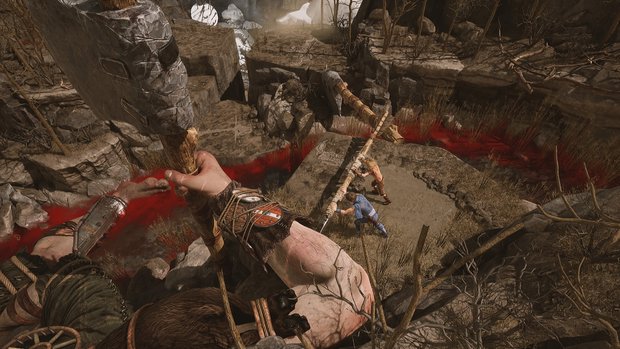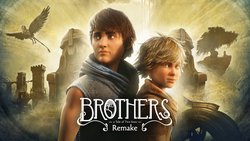Brothers: A Tale of Two Sons remake review

- 0 Comments
Beautifully remastered 2013 fantasy action-adventure akin to the best interactive storytelling experiences
It’s rare for me to replay games, both because of an intense loathing of repeating myself, and because there’s always something new and interesting to play instead. But then they went and remade Brothers: A Tale of Two Sons, and I couldn’t resist. I certainly tried – as much as I loved Starbreeze Studios’ unique dual-character action-adventure when it first released in 2013, the story is the same, the gameplay’s the same, and it was already a beautiful work of isometric art that didn’t really scream out for a remaster, let alone a mere decade later. And yet there’s no question the new version adds a significant new layer of eye candy, and it comes with a probably-long-overdue option to share the experience with a friend. But whether played co-op or solo, this is a welcome update to an already wonderful game, and I thoroughly (well, mostly) enjoyed myself just as much the second time around, braced as I was for the emotional wallop I knew it packed.
The story of Brothers can be summed up pretty much like this: Two (unnamed) boys set out on a cross-country adventure in search of medicine for their ailing father. That’s it. Okay, there’s more to it, of course, like the tragic backstory involving their mother teased out gradually here and there, but for the most part the same basic premise drives the action along. I don’t dare say too much, as the joy of this game is in discovering new experiences for yourself, but among other things you’ll encounter an imprisoned mushroom troll whose husband is desperately trying to find her, a town being terrorized by an invisible behemoth able to turn its prey to ice, and the aftermath of a deadly battle between giants, whose fresh blood stains the rivers red, their vulture-picked mammoth corpses left to pose physical barriers to overcome. Occasionally you’ll help in times of need, such as freeing a wounded bird or attempting to rescue a young woman about to be ritually sacrificed, but just as often you’ll arrive too late to do so. After all, this is not an epic story of an entire Middle-earth-type realm, but the much smaller, more intimate tale of two brothers.
Speaking of Middle-earth, the stunning natural settings call to mind Peter Jackson’s Lord of the Rings trilogy, filled with pastoral villages, rocky cliffs, creepy forests, dark caverns, snow-covered mountains, and flowing waters of various types. Occasionally you’ll meet up with fellow humans, domestic or wild animals, monsters, and other fantastical creatures, accompanied by a vibrant ambient soundscape. There’s nothing much any fantasy fan won’t have seen before, and yet rather than coming across as derivative, it feels like a cohesive, lived-in world all its own that you’re only passing through, with stories that predate your arrival and continue on after your departure like the best journeys should.

Without a visual side-by-side comparison, it wasn’t clear to me at first just how much crisper the game looks now. Brothers was always such an artistically gorgeous adventure that it doesn’t depend on high polygon counts or other whiz-bang technical elements to make it pretty. But after refreshing my memory of the original by watching the hour-long video with developer commentary from writer-director Josef Fares, wow, the enhancements are impressive! It’s still not going to rival the biggest-budgeted AAA titles for ultra-realism, and I ran into one or two graphical glitches, but the textures are so much sharper now, a fact you can stop and appreciate when seated at one of the many scattered benches that provide a panoramic overview of the current area, or admire from above during a soaring flight sequence. The lighting during nighttime sequences in particular has been significantly overhauled as well, all the better to see the glowing eyes of prowling wolves.
The many interwoven cinematics have been enhanced, too, giving Fares (an accomplished filmmaker before making Brothers his first game) a chance to emphasize the more powerful moments. Visual storytelling is more important here than in many games, because there is no spoken language at all. Well, there is, but words are rarely spoken and when they are, they’re uttered in an unintelligible variation of the director’s native Arabic language with no subtitles, leaving players to interpret what’s being said for themselves from animated gestures alone. While some may wish for more exposition to spell things out, the relative silence – aided by a wonderful score with a wide range of evocative flutes, brass, strings and vocals – works in the game’s favour, placing the emphasis primarily on emotion rather than information.
The transient nature of the journey and the constantly changing environments really serve to limit any sense of repetition in this game. (Whew!) Each major location (split into chapters that can be replayed from the main menu once completed) has its own types of tasks – some puzzle-based, some more physical in nature – that suit the circumstances but are then left behind when you move on. The most puzzly bits generally involve the two brothers working separately but cooperatively, such as each brother alternately guiding the other through a series of obstacles using levers, cranes, bridges or other contraptions. Sometimes they’ll need to join forces more directly to mutually carry a large two-person object or perform an action that one alone cannot. The game is so linear that a solution is always close at hand, but the tasks feel so organic to the quest that they’re nevertheless always rewarding to solve.

Then there’s the “action” segments. For those who break out in cold sweats at the mere mention of the word, rest assured that the action here is very adventurer-friendly. Yes, there’s running, jumping, climbing, and even bosses to defeat, but all this is accomplished with a mere TWO buttons: move and interact. The boys jog at a manageable pace even at top speed, and jumping gaps, shuffling across narrow ledges or climbing traversable obstacles is done automatically simply by moving towards them. For harder-to-reach spots, the all-purpose interact button will perform a hop and grab (when held down). Leaping from one clearly defined handhold to another is as simple as aiming in the intended direction (indicated, where possible, by the boys reaching that way), letting go of the interact button, then timing it right to trigger again to grab hold. Jumping by releasing a button may seem a little counterintuitive, but with only two options available, it certainly isn’t hard to master.
Additional challenge is added as you go along, but always using the same fundamental controls, such as distracting and dodging an angry mutt by alternating dashes to safe spaces, or when the two boys are bound by a rope and must use physical momentum to swing each other across castle ruins and crumbling statues without falling. Boss fights are more complex still, but since combat is out of the question, these set pieces are really just a matter of figuring out the right strategy for taking them down. Die and you’ll simply respawn at the start to try again, none the worse for wear (though one of them, at least, involves sitting through the same preceding cutscene each time, with no way to skip what you’ve already seen). You can die elsewhere too, but Brothers is not only quite forgiving, it’ll helpfully prevent you from accidentally running off cliffs or precarious walkways.
Naturally, the two boys have their own strengths and weaknesses: the smaller one can slip through gaps the larger one cannot, while big brother is stronger and can move things too heavy for little bro to budge. Only the older brother can swim, so any deep water or swift current scenarios will require piggybacking a ride to shore. For the most part, though, the lads are both capable of the same things – each can jump the same distance and support the other’s weight, for instance – and can be used interchangeably.
There’s no indication of hotspots, but they’re fairly obvious in context and you’re encouraged to experiment anyway, as the two boys will react differently to various people and objects. Little bro has a more carefree, playful and compassionate attitude (which admittedly doesn’t always suit the dire circumstances) while big brother has a more detached, grown-up demeanour. Certain interactions are entirely optional, but short little side quests are well worth pursuing for reasons much deeper than earning achievements (though they’ll obviously do that too), even if they don’t ultimately impact the boys’ journey.

As good as all that is, it’s still pretty traditional action-adventure fare for the most part, just a little more streamlined than most. What makes Brothers especially unique is its love-it-or-hate-it method of handling dual-character controls. Lots of games have multiple protagonists, but here you don’t switch between them but rather control them both simultaneously. Using a gamepad – or conceivably a keyboard if you’re a masochist – you’ll guide big brother with the left thumbstick and bumper and little bro with the right. There’s no cheating by leaving one behind to focus on the other, either, as the maximum space allowed between them is quite restrictive.
It’s a really interesting approach that reinforces the notion of a shared experience, but I’ll admit that even the second time through it would sometimes hurt my brain a little. Getting the controls mixed up in the heat of the moment can be seriously discombobulating. It’s one thing to simply send the two brothers scurrying off in opposite directions and fumble their way back together, but quite another to momentarily lose track and have the wrong brother let go of a ledge. Oops! In part this is just dumb user error, but part of the blame falls on what I consider the game’s biggest omission, even in the remake.
While different accessibility options are offered, there is NO option to reverse hands for big and little brothers. As a right-handed person, I was stubbornly hardwired to equate the little brother with my weaker hand and big brother with my stronger one, so it was a constant battle to overcome that instinctive impulse, and not always successful. Only during the developer commentary did I discover a possible explanation for it. It seems the camera – which you have some control over to pan manually but will automatically try to rotate to provide the best viewpoint – is programmed to position the appropriate brother on the same side as their corresponding controls (big brother on the left side, small brother on the right). Smart! That didn’t even occur to me, so maybe it’s mostly dumb user error after all. Then again, you’re often on the move so this kind of camera reorientation rarely happens. It’s only during the quieter, more passive moments that it has time to fully adjust, and it’s still not clear to me why that wouldn’t be possible with the two brothers reversed. Thinking about it is making my head hurt again.
Anyway, the single-player control issue of the original game may have put off some players who found it unintuitive. That’s where the other major feature of the remake comes in, as the game now allows two players to control the two brothers separately. I didn’t try the local co-op option myself, but the benefit is obvious: no broken brain! I can certainly imagine the shared experience to be a very pleasant one, freed of the responsibility of juggling both brothers at once. However, unless you patiently take turns, you might miss some of the other brother’s optional interactions that way. You’ll definitely miss out on a late-game sequence that is cleverly designed to subvert control expectations for single players. It’s hardly a deal-breaker, but it’s worth going back and trying the last chapter or two again alone, which you can easily do from the main menu. The other obvious consequence of sharing controls is in making the game even easier. Juggling both brothers was originally meant to be a baked-in part of the challenge, and without that there’s little to slow you down. Even for one person the game’s difficulty is quite mild; for two it’s practically a breeze that will shave even more time off the three-to-four-hour solo experience.
[No spoilers, but skip this next paragraph if you don’t want to know anything about the ending] Whether finishing the journey alone or with a partner, one of you might want to bring the Kleenex. Brothers offers an emotional roller-coaster throughout, but it saves its most affecting moments for the end. And yet it’s not done in a cloying, manipulative way. Again, Fares’s experience as a filmmaker serves the game well in this respect. As in real life, there is joy and hope mixed in with despair; pain and anger mixed in with periods of elation, and it’s all a sometimes-gut-wrenching part of family and growing up. There’s even room left for personal interpretation of events, leaving it to players to answer some bigger questions for themselves.
Final Verdict
If you’ve never played Brothers: A Tale of Two Sons, I enthusiastically encourage everyone to do so. If you’ve already played the original, it’s a more guarded recommendation, as the remake is really just the same game with more realistic graphics, but the co-op feature is a great way to introduce it to friends to share in the experience together. (If for some reason you prefer the more stylized graphics from 2013, that version is still available as well.) Either way, don’t let the “action” element deter you, as it’s more a matter of keeping cool and taking your time than having quick reflexes. The puzzles won’t put up much of a fight, but this sibling journey packs a surprising amount of actual adventure into its relatively brief runtime. And for those who enjoy a good story (and perhaps occasionally a good cry), it’s a cinematic delight with a rich emotional drama at its core that is sure to touch even the hardest heart. Two thumbs up.
Hot take
It’s much the same as fans will remember, but the Brothers remake pairs an already wonderful game with a stunning graphic overhaul and co-op multiplayer option.
Pros
- Diverse fantasy environments and animations look better than ever
- Wordless story packs a strong emotional punch
- Two-player co-op option a new alternative to unique dual-character solo controls
- Quick pace and varied gameplay keep things always fresh
- Feels like an intimate slice of a larger world you’re only passing through
Cons
- No option to reverse control hands for the two brothers
- Fairly short and easy, with not much new for those who played the original
Jack played Brothers: A Tale of Two Sons on PC using a review code provided by the game's publisher.











0 Comments
Want to join the discussion? Leave a comment as guest, sign in or register in our forums.
Leave a comment